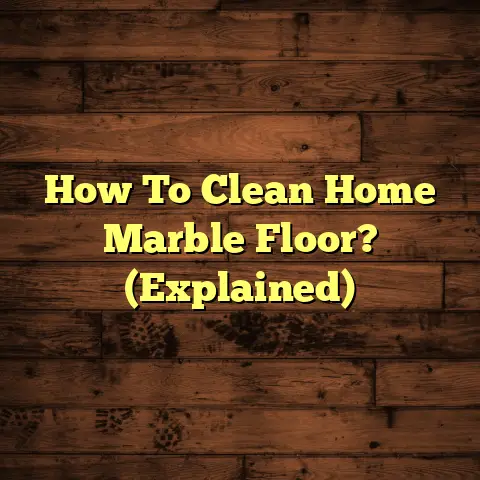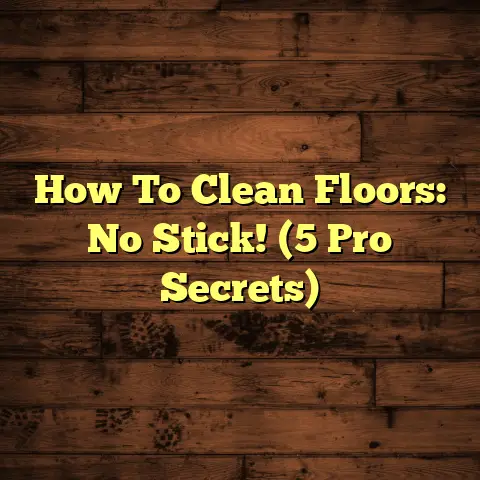Remove Floor Cleaner Residue (4 Urgent Tips!)
If they’re sparkling clean and well-maintained, it instantly creates a positive impression.
But if they’re dull, grimy, or covered in a hazy film, it can be a major turn-off for potential buyers.
And that’s where floor cleaner residue comes in – a silent culprit that can sabotage your home’s chances of fetching top dollar.
Floor cleaner residue is that annoying, often invisible, layer of gunk that builds up on your floors over time.
It’s like a magnet for dirt and grime, dulling the finish and making your floors look older than they actually are.
Trust me, I’ve walked into houses where the floors were so bad, it felt like walking on sandpaper!
But here’s the good news: removing floor cleaner residue is totally doable, and it doesn’t have to break the bank.
In this article, I’m going to share my top 4 urgent tips for tackling this problem head-on, so you can protect your home’s value and make a stellar impression on potential buyers.
So, grab a cup of coffee, and let’s dive in!
Section 1: Understanding Floor Cleaner Residue
Okay, so what exactly is floor cleaner residue?
Well, it’s basically a buildup of leftover cleaning products, mixed with dirt, dust, and other contaminants.
Think of it as a sticky film that clings to your floors, attracting even more grime over time.
The main culprits behind floor cleaner residue are often the ingredients in your cleaning solutions themselves.
Things like:
- Wax: Some floor cleaners contain wax to add shine, but over time, this wax can build up and create a dull, sticky layer.
- Soaps and Detergents: Many all-purpose cleaners contain soaps and detergents that can leave behind a residue, especially if they’re not properly rinsed.
- Cleaning Agents: Certain chemicals in cleaning agents can react with the flooring material, leading to a buildup of residue.
And here’s the thing: different flooring materials react differently to various cleaners. For example:
- Hardwood: Hardwood floors are particularly susceptible to residue buildup from oil-based cleaners or waxes.
- Tile: Tile floors can accumulate residue from soap-based cleaners, especially in grout lines.
- Laminate: Laminate floors can be damaged by harsh chemicals, leading to residue buildup and potential warping.
Now, you might be thinking, “Okay, so I have a little residue on my floors.
What’s the big deal?” Well, the long-term effects of neglecting this issue can be pretty significant.
Not only does it make your floors look dull and dirty, but it can also lead to:
- Wear and Tear: Residue can trap dirt and grime, which act like sandpaper on your floors, causing scratches and wear.
- Discoloration: Over time, residue can discolor your floors, making them look uneven and aged.
- Costly Repairs or Replacements: If left unaddressed, residue buildup can eventually damage your floors to the point where they need to be repaired or replaced.
And let’s not forget the impact on your home’s resale value.
According to the National Association of Realtors, homes with well-maintained flooring sell for an average of 3-5% more than those with visible maintenance issues.
That’s a significant chunk of change!
Section 2: The Importance of Immediate Action
So, now that you know what floor cleaner residue is and why it’s a problem, let’s talk about why it’s so important to address it ASAP.
First off, neglecting to remove cleaner residue can lead to slippery surfaces.
That’s a safety hazard, especially if you have kids or elderly family members living in your home.
I’ve seen too many accidents caused by slippery floors!
Secondly, residue buildup dulls the appearance of your floors, making them look dingy and uninviting.
And let’s be honest, nobody wants to walk into a house with dull, lifeless floors.
But perhaps the most concerning issue is the potential health risks associated with trapped dirt and bacteria.
Residue can create a breeding ground for germs, which can trigger allergies, asthma, and other respiratory problems.
I remember one time, I was called in to assess a house that had been on the market for months without any offers.
The floors looked terrible – dull, grimy, and just plain unappealing.
After a thorough cleaning and residue removal, the floors looked brand new, and the house sold within a week!
Here’s the thing: potential buyers are often subconsciously influenced by the cleanliness and appearance of a home.
A clean, residue-free floor can evoke feelings of comfort, trustworthiness, and pride of ownership.
It signals that the home has been well-cared for and that the previous owners took pride in their property.
Section 3: Urgent Tip #1 – Use the Right Cleaning Solution
Okay, let’s get down to brass tacks.
The first and most important step in preventing and removing floor cleaner residue is to use the right cleaning solution for your specific flooring type.
Using the wrong cleaner can actually exacerbate the problem, leading to even more residue buildup and potential damage.
So, before you grab that all-purpose cleaner, take a moment to consider what kind of floors you have.
Here are some general recommendations for different flooring types:
- Hardwood: Use a specialized wood floor cleaner that’s pH-neutral and designed to protect the finish.
Avoid oil-based cleaners, waxes, and harsh chemicals. - Tile: Use a pH-neutral tile cleaner or a solution of vinegar and water (1/2 cup vinegar per gallon of water).
Avoid soap-based cleaners, which can leave a residue in the grout lines. - Laminate: Use a laminate floor cleaner or a solution of mild dish soap and water.
Avoid harsh chemicals, abrasive cleaners, and excessive water, which can damage the laminate. - Vinyl: Use a vinyl floor cleaner or a solution of apple cider vinegar and water (1 cup vinegar per gallon of water).
Avoid abrasive cleaners and solvent-based cleaners.
Pro Tip: Always test a new cleaner on a small, inconspicuous area of your floor before applying it to the entire surface.
This will help you ensure that the cleaner doesn’t damage or discolor your floors.
How to Test a New Cleaner:
- Choose a hidden area, like a closet or under a piece of furniture.
- Apply a small amount of the cleaner to the area.
- Let it sit for the recommended time (usually a few minutes).
- Wipe it off with a clean cloth.
- Check for any signs of damage, discoloration, or residue.
Common mistakes homeowners make with cleaning solutions:
- Using too much cleaner.
- Using the wrong type of cleaner.
- Not rinsing the floor properly.
- Using abrasive cleaners on delicate surfaces.
Section 4: Urgent Tip #2 – The Correct Cleaning Technique
Now that you’ve got the right cleaning solution, it’s time to talk about technique.
Even the best cleaner won’t work if you’re not using it properly.
Here are some general tips for cleaning floors without leaving residue:
- Use the Right Tools: Invest in a good-quality mop or microfiber cloth that’s designed for your flooring type.
Avoid using abrasive scrub brushes, which can scratch your floors. - Proper Dilution: Always follow the manufacturer’s instructions for diluting your cleaning product.
Too much cleaner can lead to buildup, while too little won’t be effective. - Work in Sections: Clean your floors in small sections, working from one corner of the room to the other.
This will help you ensure that you’re cleaning every inch of the floor. - Rinse Frequently: Rinse your mop or cloth frequently in clean water to remove dirt and grime.
- Dry Thoroughly: After cleaning, dry your floors with a clean, dry mop or cloth to prevent water spots and streaks.
Detailed Cleaning Methods for Different Flooring Types:
- Hardwood: Damp-mop with a specialized wood floor cleaner, following the grain of the wood.
Avoid using excessive water, which can damage the wood. - Tile: Mop with a pH-neutral tile cleaner or a solution of vinegar and water, paying special attention to the grout lines.
Use a grout brush to scrub stubborn stains. - Laminate: Damp-mop with a laminate floor cleaner or a solution of mild dish soap and water.
Avoid using excessive water, which can damage the laminate. - Vinyl: Mop with a vinyl floor cleaner or a solution of apple cider vinegar and water.
Avoid using abrasive cleaners, which can scratch the vinyl.
Assessing the Effectiveness of Your Cleaning Method:
- Check for streaks or water spots.
- Feel the floor for any stickiness or residue.
- Inspect the grout lines for dirt and grime.
- Look for any signs of damage or discoloration.
Section 5: Urgent Tip #3 – Rinse Well
This might seem obvious, but rinsing your floors after cleaning is absolutely crucial for removing all traces of cleaning agent residue.
Think of it like washing your hair – you wouldn’t leave shampoo in it, would you?
The same goes for your floors.
Rinsing removes any lingering cleaner, dirt, and grime, leaving your floors clean, fresh, and residue-free.
Rinsing Techniques for Different Flooring Types:
- Hardwood: Damp-mop with clean water, following the grain of the wood.
Use a microfiber cloth to dry the floor thoroughly. - Tile: Mop with clean water, paying special attention to the grout lines.
Use a clean, dry cloth to wipe up any excess water. - Laminate: Damp-mop with clean water. Use a microfiber cloth to dry the floor thoroughly.
- Vinyl: Mop with clean water.
Use a clean, dry cloth to wipe up any excess water.
Clean Water vs. Diluted Cleaning Solution for Rinsing:
I always recommend using clean water for rinsing, rather than a diluted cleaning solution.
This ensures that you’re removing all traces of the cleaning agent, rather than just diluting it.
Drying the Floor After Rinsing:
Drying your floors after rinsing is just as important as rinsing itself.
This prevents water spots, streaks, and further residue buildup.
Tips for Drying Your Floors:
- Use a clean, dry mop or microfiber cloth.
- Work in sections, drying each area thoroughly.
- Open windows or use a fan to speed up the drying process.
Section 6: Urgent Tip #4 – Regular Maintenance and Preventative Measures
Okay, so you’ve cleaned your floors and removed the residue.
Now what?
The key to keeping your floors looking their best is to establish a regular cleaning schedule and take preventative measures to minimize dirt and residue buildup.
Why Regular Maintenance is Important:
- Prevents buildup of cleaner residue and dirt.
- Extends the life of your floors.
- Maintains the appearance of your home.
- Protects your investment.
Homeowner’s Floor Maintenance Checklist:
- Weekly: Sweep or vacuum floors to remove loose dirt and debris.
- Monthly: Mop floors with the appropriate cleaning solution.
- Seasonally: Deep-clean floors to remove stubborn stains and residue.
- As Needed: Spot-clean spills and stains immediately.
Preventative Measures to Minimize Dirt and Residue Accumulation:
- Use Mats and Rugs: Place mats and rugs in high-traffic areas, such as entryways and hallways, to trap dirt and debris.
- Take Off Your Shoes: Encourage family members and guests to remove their shoes before entering your home.
- Clean Up Spills Immediately: Wipe up spills as soon as they happen to prevent staining and residue buildup.
- Avoid Harsh Chemicals: Use gentle, pH-neutral cleaning products that are designed for your flooring type.
The Role of Professional Cleaning Services:
While regular DIY cleaning is important, professional cleaning services can provide a deeper, more thorough cleaning that removes stubborn stains and residue.
Professional cleaners have the equipment and expertise to clean your floors safely and effectively, without damaging the finish.
Conclusion
So, there you have it – my top 4 urgent tips for removing floor cleaner residue and protecting your home’s resale value.
Remember, a well-maintained floor is not only beautiful but also a smart investment for the future.
By using the right cleaning solutions, employing the correct cleaning techniques, rinsing thoroughly, and establishing a regular maintenance schedule, you can keep your floors looking their best and make a stellar impression on potential buyers.
Don’t wait until you’re ready to sell your home to start taking care of your floors.
Start today, and you’ll be amazed at the difference it makes!





